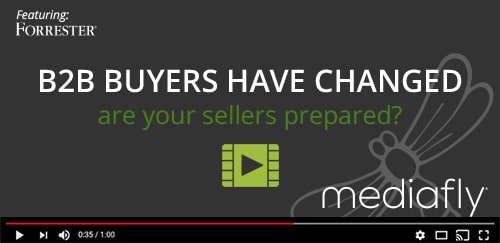Sales enablement technology: Leveraging a mobile platform for strategic selling
The behaviors of B2B buyers are changing, and sales transformation is no longer an option. The modern B2B buyer has evolved into a hybrid of characteristics seen in B2B and B2C consumers. Their engagement preferences have changed as they’re more self-directed when it comes to research and purchasing decisions.
As a result, the modern B2B seller needs to evolve with the buyer to engage them differently. In our recent webinar, we outlined recommendations for ways both sales and marketing can do this.
Remove barriers to dynamic selling: sales efficiency
Sales reps are only spending 35.9% of their time selling. This means over 60% of their time is spent on administrative tasks such as searching for content, creating materials, assembling presentations and following up with prospects. That equates to three full days each week in which a seller is not selling. How can we fix this?
Aligning sales and marketing on the distribution, usage, and effectiveness of content is one of the first steps in the Evolved Selling™ journey. More and more companies are using email to distribute content to their salespeople. In fact, this number has increased from 24.9% to 29% in the last year. When content is housed in email systems, it tends to get lost, overlooked or forgotten. Sellers will continue to use outdated versions of content, or even worse, will ping marketing to ask where the latest content is. Using a content management system (CMS) allows sales to trust they have access to the most recent materials and allows marketing to measure usage and adoption.
By distributing content through a CMS, marketing has visibility into what content is used (or not used) and what content is effective (or ineffective). This information helps establish a framework to provide sellers with the most compelling content for each stage in the process, boosting sales acceleration. It also reduces the amount of time sellers are spending on searching and creating content when they have what they need in their hands.
Tailor the selling experience: sales productivity
Along with sales efficiency comes sales effectiveness. Enabling sellers to tailor each interaction to the needs of individual buyers is the key to success. It’s time to accept that static pitch decks are out of date, and there is no “one size fits all” sales process. Instead, marketing should create modularized content that best conveys the value of the company and solutions. Understanding that no two sales experiences should be the same, the ability to mix and match content to address buyers’ needs provides a personalized engagement and creates confidence throughout the partnership.
To execute, sales and marketing alignment is crucial. Creating compelling content is not enough. The second step is ensuring sellers know how and when to leverage different materials. When marketing pushes suggested content based on the industry, buyer persona or stage of a sales opportunity, it confirms the item has a purpose and provides value for the buyer journey.
Create an interactive buying experience: sales effectiveness
In today’s world, buyers are distracted by their phones and emails, even during face-to-face interactions. Keeping them engaged throughout the conversation is easier said than done. Leveraging interactive tools such as ROI calculators or guided selling techniques that require their input will keep their interest level high.
When a buyer realizes the presentation is unfolding in the moment based on their participation, they’re more likely to establish trust in the seller. Buyers want to learn something new, and sellers have a great opportunity to do this by incorporating engaging elements. This can be as simple as asking the buyer a few questions and allowing their answers to dictate the content presented.
Use custom data in real-time: sales success
In conjunction with interactive experiences, leveraging data differentiates sellers in the field by showing buyers something relevant and new. Incorporating 3rd party data, CRM data or industry-specific data provides a competitive advantage, and back to the first point, tailors the experience specific to each buyer. This data-driven experience shows the buyer you’re an expert in their field and can offer insight into their business.
Evolved Selling™ is the idea that organizations enable sellers to enhance their customer interactions by providing value at every step. Buyers are taking it upon themselves to learn about product offerings and expect sales interactions to show them how an offering will impact their business.
About Mediafly
Mediafly was founded on the principle that people hate being sold to because it rarely addresses their needs. By using our technology, the world’s top companies are able to shape sales presentations in real-time, rather than boring their customers with generic pitch decks built the night before. Sales teams using Mediafly are more effective in each meeting because they engage their customers with insights that are relevant to them. We call this Evolved Selling™.
B2B Buyers Have Changed Are Your Sellers Prepared Webinar
B2B Buyers Have Changed Are Your Sellers Prepared Infographic


Comments are closed.